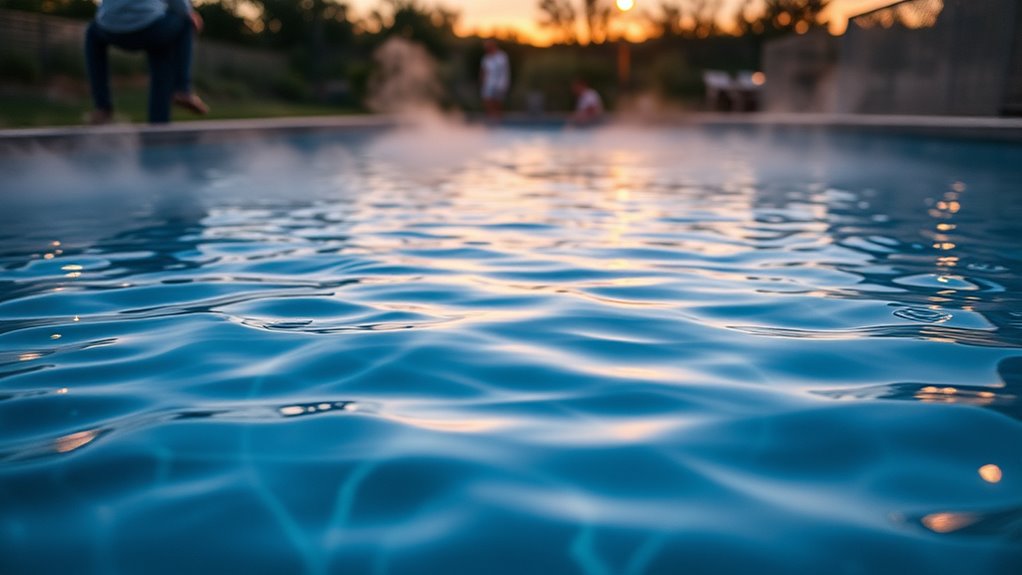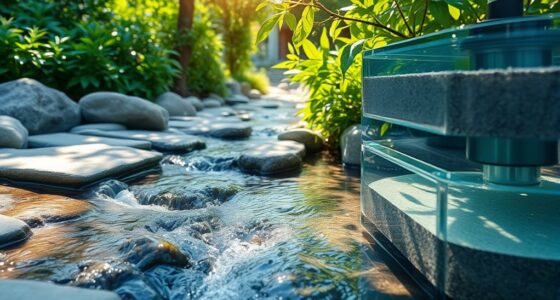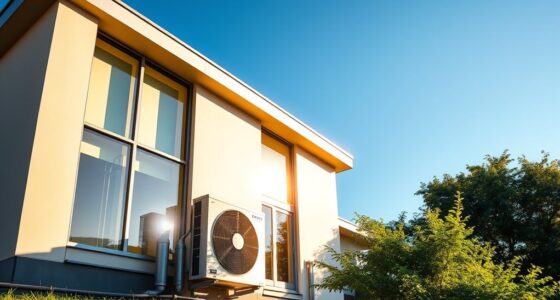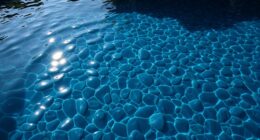Heat loss in pools happens mainly through conduction, convection, and radiation. Conduction transfers heat directly from the water to cooler materials or air touching the surface. Convection occurs when cool air or water moves over the surface, carrying heat away faster. Radiation happens when the pool surface emits infrared energy, especially under clear, cold conditions. Understanding these mechanisms helps you find effective ways to reduce heat loss and keep your pool warm; explore further to learn how to optimize insulation and covers.
Key Takeaways
- Heat loss in pools occurs mainly through conduction, convection, and radiation, each influenced by different physical processes.
- Conduction transfers heat directly through pool walls and floors, especially if poorly insulated.
- Convection involves heat loss through circulating water and airflow, accelerated by wind and open surfaces.
- Radiation causes heat to emit infrared energy, influenced by surface color, material, and surroundings.
- Effective heat management reduces energy costs by addressing the dominant heat transfer mechanisms.
How Conduction Causes Heat Loss in Pools
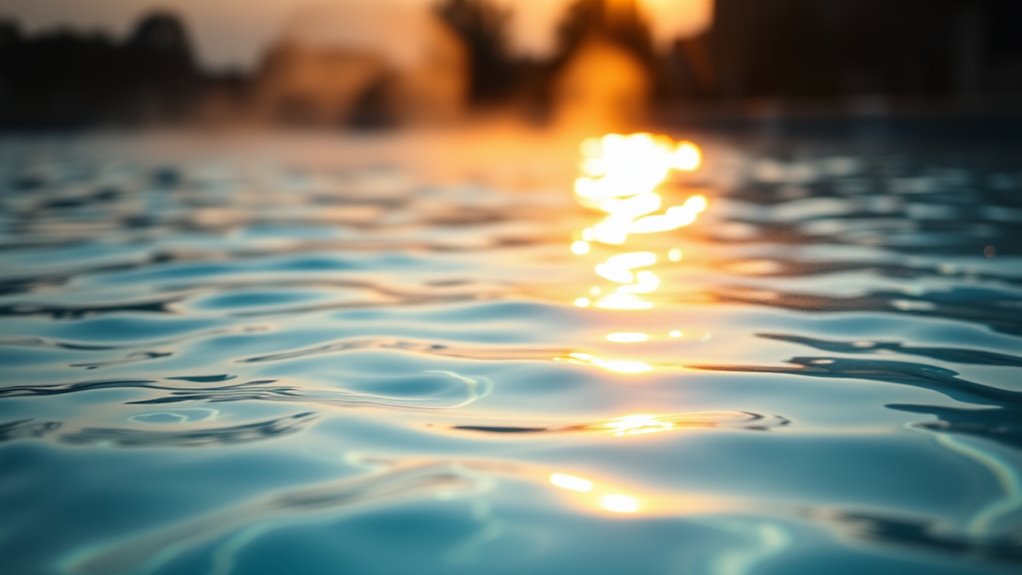
Conduction causes heat loss in pools when heat transfers directly from the warmer water to the cooler surrounding materials, such as the pool’s walls, floor, or the air just above the water surface. When the water’s temperature is higher than these surfaces, heat moves through direct contact, transferring energy from the water to the cooler material. For example, the pool’s concrete walls and floor conduct heat away from the water, especially if they are made of materials with high thermal conductivity. The process is continuous, and the rate depends on the temperature difference, the thermal conductivity of the materials, and the contact area. To minimize conduction heat loss, insulating materials or covers can be used to slow down this heat transfer. Additionally, using insulating materials around the pool can significantly reduce heat conduction to the environment.
The Role of Convection in Cooling Pool Water

As heat moves from the warm water to its cooler surroundings, convection plays a significant role in speeding up the cooling process. You can see this in action when cooler air or water flows over the pool surface, carrying away heat. Convection involves the movement of fluid, which helps distribute heat more evenly and accelerates heat loss. To understand this better:
Convection speeds up cooling by circulating fluid and removing heat from the surface.
- Cooler air or water flows over the surface, removing heat from the water.
- Warm water rises to the surface, where it loses heat faster.
- This continuous circulation enhances overall cooling efficiency.
- Incorporating proper ventilation can further improve heat transfer rates and promote faster cooling.
Understanding Radiative Heat Transfer From Pool Surfaces

Your pool’s surface properties, like color and material, influence how much heat it radiates. The surroundings, including air temperature and nearby objects, also affect heat loss through radiation. Understanding these factors helps you better estimate and manage your pool’s heat retention. Additionally, the surface properties of your pool can affect how much heat is lost through radiation, making it important to consider materials and finishes when planning for heat retention.
Emission Surface Properties
Have you ever wondered how the surface properties of a pool influence its heat loss through radiation? The emission surface properties, especially the surface’s emissivity, determine how effectively it radiates heat. A surface with high emissivity (close to 1) emits more infrared radiation, leading to greater heat loss. Conversely, surfaces with low emissivity reflect more radiation and lose less heat. Additionally, the methods for measuring emissivity help in assessing and optimizing thermal performance.
Key factors include:
- Surface Material: Dark, matte surfaces have higher emissivity than shiny, reflective ones.
- Surface Temperature: Hotter surfaces emit more radiation.
- Surface Texture: Rough textures increase emissivity compared to smooth finishes.
Understanding these properties helps you predict and control heat loss, optimizing pool insulation and efficiency.
Effect of Surroundings
Surroundings play a crucial role in radiative heat transfer from pool surfaces by either absorbing, reflecting, or transmitting infrared radiation. If your surroundings are made of dark, matte materials, they tend to absorb more infrared radiation, increasing heat loss from the pool. Conversely, reflective surfaces like white-painted walls or water bodies with high albedo bounce radiation back toward the pool, reducing heat loss. Transparent surroundings, such as glass or plastic enclosures, allow infrared radiation to pass through, which can either trap heat or facilitate heat exchange with external environments. The temperature difference between the pool surface and its surroundings also influences the net radiative heat transfer. Additionally, the material properties of the surroundings significantly affect how much heat is absorbed or reflected, impacting overall heat retention. Understanding this interaction helps you optimize pool insulation and minimize heat loss effectively.
Factors That Influence Heat Loss Mechanisms
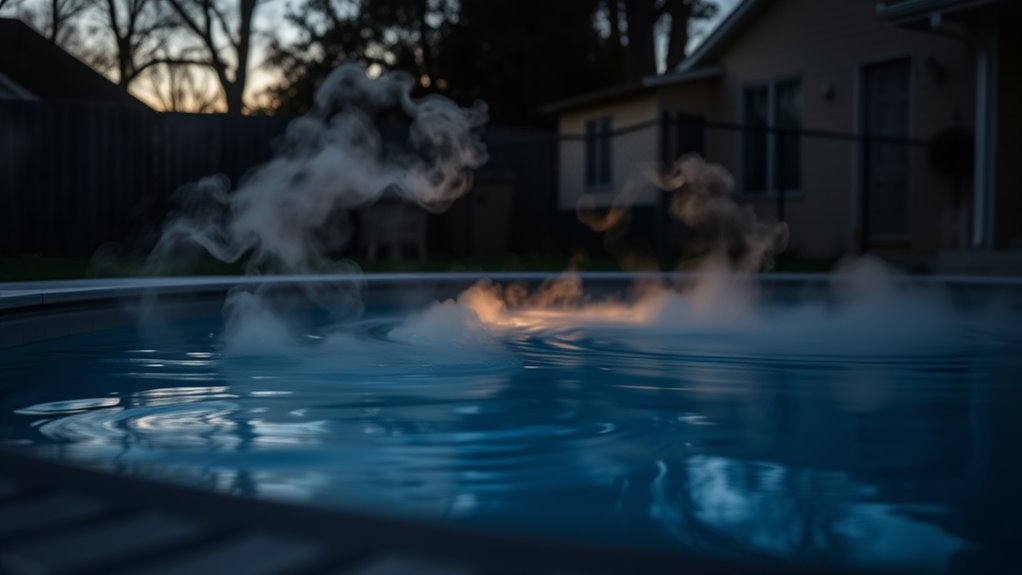
Several factors influence how heat escapes from a space, directly affecting the rate and mode of heat loss. These factors determine whether conduction, convection, or radiation dominates. First, the temperature difference between your pool and the surroundings plays a pivotal role; the greater the difference, the faster heat escapes. Second, the surface area impacts heat loss—larger surfaces increase the potential for heat transfer. Third, the material and insulation of your pool influence how well heat is retained; poorly insulated pools lose heat more quickly. Other factors include wind speed, humidity, and the pool’s cover. Understanding these elements helps you assess how quickly your pool loses heat and guides you in choosing effective methods to reduce it. Additionally, awareness of creative problem-solving techniques can inspire innovative solutions for improving pool insulation and heat retention.
Practical Ways to Minimize Heat Loss
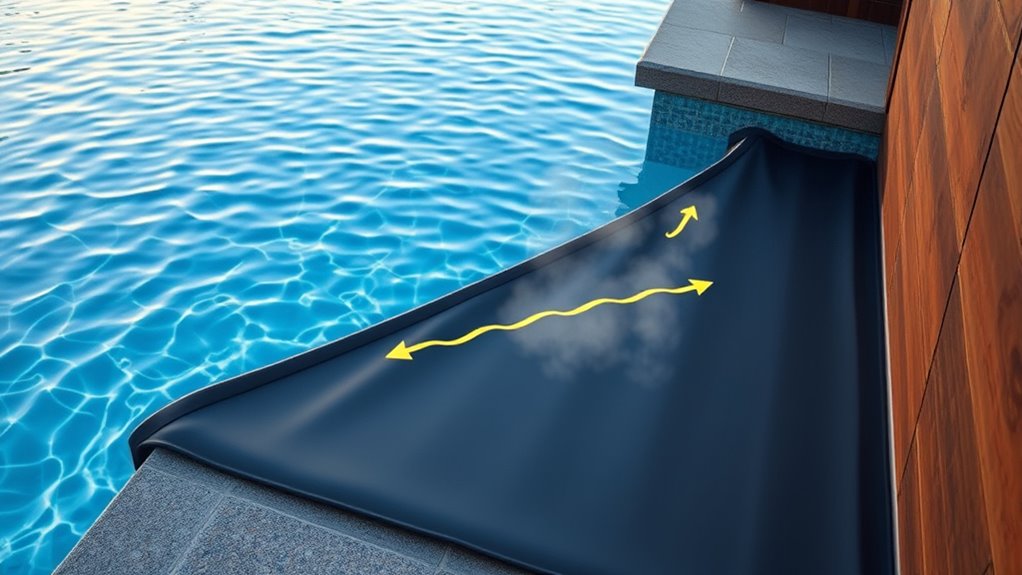
You can reduce heat loss from your pool by using it with a cover whenever it’s not in use. Insulating the pool surfaces also helps keep the heat in more effectively. Implementing these simple measures can substantially cut down on energy costs and maintain a warmer pool. Additionally, understanding heat transfer methods allows you to better select and apply insulation and covers for maximum efficiency.
Use Pool Covers Effectively
Using a pool cover consistently is one of the most effective ways to reduce heat loss. When you cover your pool, you create a barrier that minimizes evaporation, convection, and radiation. To maximize its benefits:
- Use the cover whenever the pool isn’t in use, especially overnight.
- Ensure the cover fits snugly to prevent heat from escaping around the edges.
- Clean the cover regularly to maintain its insulating properties and prevent debris buildup.
- Incorporate mechanical gear elements into your pool cover design to enhance durability and insulation properties.
A well-maintained cover reduces water evaporation, which is a major source of heat loss. It also slows down heat exchange with the cooler air and limits radiation escape. By making cover use a routine, you’ll keep your pool warmer and save energy.
Insulate Pool Surfaces
Covering your pool with a tarp or insulating material adds an extra layer of protection against heat loss. Insulating your pool surfaces helps reduce heat transfer through conduction, especially on cooler nights or during off-season periods. You can install foam board insulation around the pool’s perimeter or use specially designed insulating blankets that float on the water’s surface. These options act as barriers, trapping heat and preventing it from escaping into the cooler air. Insulating the sides and bottom of your pool minimizes heat loss through contact with the ground, which often conducts heat away. Proper insulation not only conserves warmth but also reduces the workload on your heating system, saving you energy and money while keeping your pool comfortable longer. Additionally, understanding heat transfer mechanisms can help you choose the most effective insulation strategies for your setup.
Comparing the Impact of Different Heat Loss Methods
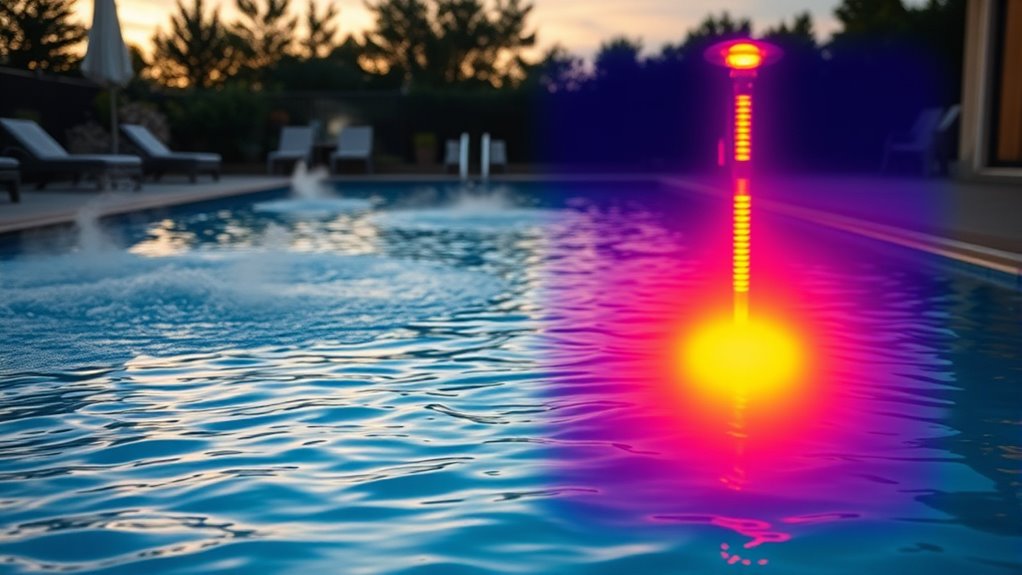
Different heat loss methods vary considerably in their impact on overall energy efficiency. Conduction transfers heat directly through pool surfaces, often the biggest culprit if surfaces aren’t well-insulated. Convection involves heat moving away from the water’s surface, especially in windy conditions, which can markedly lower temperature. Radiation emits heat in the form of infrared rays, escaping even if the pool is covered. To understand their effects better, consider:
- Conduction causes rapid heat loss through poorly insulated surfaces.
- Convection increases heat loss with higher wind speeds and open water surfaces.
- Radiation results in steady heat escape, especially during clear, cold nights.
- The contrast ratio of a projector can influence how well it displays details in dark scenes, affecting the viewer’s experience.
Knowing which methods dominate helps you target your efforts to minimize energy loss efficiently.
Frequently Asked Questions
How Do Pool Cover Materials Affect Heat Retention?
Pool cover materials substantially improve heat retention by acting as a barrier against heat loss. When you choose a cover with insulating properties, it reduces evaporation and heat transfer through conduction and convection. A good cover traps warm air above the water, keeping your pool warmer for longer. You’ll notice your pool stays comfortable longer, saves energy, and cuts costs on heating. Opt for covers made from materials like bubble wraps or solar blankets for best results.
Can Chemical Treatments Influence Heat Loss Rates?
Chemical treatments like chlorine or algaecides don’t directly impact heat loss rates in your pool. However, maintaining proper chemical balance helps prevent algae and bacteria, which can cause surface disturbances and increase evaporation. Reduced evaporation means less heat escapes. So, while chemicals don’t directly insulate your pool, keeping your water balanced supports overall heat retention by minimizing water loss and surface evaporation.
What Is the Impact of Climate on Heat Transfer Methods?
You’ll notice that climate greatly impacts heat transfer in pools. In colder climates, heat loss can be up to 80% higher due to increased convection and radiation. When temperatures drop, your pool loses heat more rapidly, especially if it’s exposed to wind and low air temperatures. To minimize this, you might use covers or windbreaks, which help retain warmth and reduce the effects of cold weather on heat transfer.
How Does Pool Size and Shape Alter Heat Loss?
You’ll find that larger pools lose heat more slowly because their volume retains warmth better, while smaller pools cool down quicker. The shape also matters; irregular or shallow pools increase surface area, speeding up heat loss, especially through radiation and convection. Conversely, deeper, compact pools minimize surface exposure, helping maintain temperature. So, designing your pool with size and shape in mind can optimize heating efficiency and reduce energy costs.
Are There Eco-Friendly Solutions to Reduce Heat Loss?
Imagine wrapping your pool in a cozy, eco-friendly blanket. Solar covers, made from sustainable materials, trap heat and reduce evaporation, saving energy naturally. Using solar heaters harnesses the sun’s power, cutting reliance on electricity. Planting windbreaks can also block chilly breezes. These green solutions act like a warm hug for your pool, lowering heat loss while protecting the environment. You’ll enjoy warmer water without harming the planet.
Conclusion
Understanding how conduction, convection, and radiation cause heat loss helps you better insulate your pool. While some might think covering your pool is enough, addressing all these mechanisms ensures maximum efficiency. Don’t overlook factors like wind or surface exposure that can amplify heat loss. By actively managing these elements, you’ll enjoy warmer water longer and save on energy costs. Investing in thorough solutions truly makes a difference—because a well-insulated pool isn’t just about comfort, it’s about smarter, more sustainable heating.
